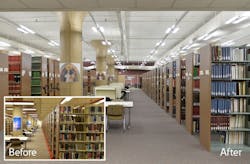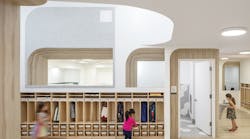Planar, light-guide-based SSL products offer adjustable mechanical form factor and deliver both indirect and direct light along with significant energy savings relative to the fluorescent incumbents.
Eaton's Cooper Lighting has announced a project in the Gumberg Library at Duquesne University in Pittsburgh, PA in which ceiling-suspended fluorescent fixtures were replaced with Cooper Neo-Ray Index pendant luminaires. The solid-state lighting (SSL) products deliver indirect light off the ceiling and direct light to work surfaces. The project also included the installation of Metalux Encounter LED Series fixtures and Portfolio LED recessed downlights in offices and hallways.
The library project, encompassing the first floor of the facility, has already been judged a success by the staff and students. "The first floor feels more vibrant and inviting," says Kelley Cotter, marketing and electronic communications librarian at the Gumberg Library. "You can easily see the difference with the new, near-daylight LED lighting. The library staff has commented that since the lights were installed, they have noticed an increase in the volume of students studying on the first floor."
The Neo-Ray Index luminaires are based on the WaveStream light-guide-based optical system that Cooper developed after licensing the baseline technology from Rambus. Cooper first showed WaveStream-based products at LightFair International in 2013. LEDs light the WaveStream optics from the edge while the planar light guide emits inherently uniform light. Moreover, the optics can deliver illumination from both sides of the light guide as is the case with the library lighting.
Cooper announced the Neo-Ray Index product about one year ago. The light-guide-based luminaire was also recognized as a finalist in the LEDs Magazine Sapphire Awards program. Ultimately, the product lost out in the Indoor Luminaire Design category narrowly, receiving a score of 4 out of 5 Sapphires.
In the library application, the luminaires have both a sleek look and deliver functional light. The light-guide-based fixtures are adjustable in terms of the angle of the planar optics. Each panel can be adjusted upwards or downwards by 15° from the neutral position.
While judgment of the light quality from the fixtures is perhaps a matter of opinion, the energy savings are completely documented. The university pursued the retrofit as part of its sustainability initiative, and the long hours of lighting operation required in the library made it a good target.
The library previously had more than 500 fluorescent fixtures on the first floor consuming more than 37 kW. Those fixtures were replaced with 110 Neo-Ray Index fixtures consuming just over 5 kW. The change will save more than 235 kWh of energy annually, equal to 357,730 pounds of carbon emissions.
"The lighting upgrade is just one of the university’s award-winning, ongoing sustainability initiatives, which include an on-site cogeneration plant and ice storage units for most of the campus’ heating and cooling needs," said Rod Dobish, executive director of facilities management, Duquesne. "Over many years, Duquesne has solidified its commitment to sustainability, following our strategic plan and the priorities of good stewardship of the environment."






